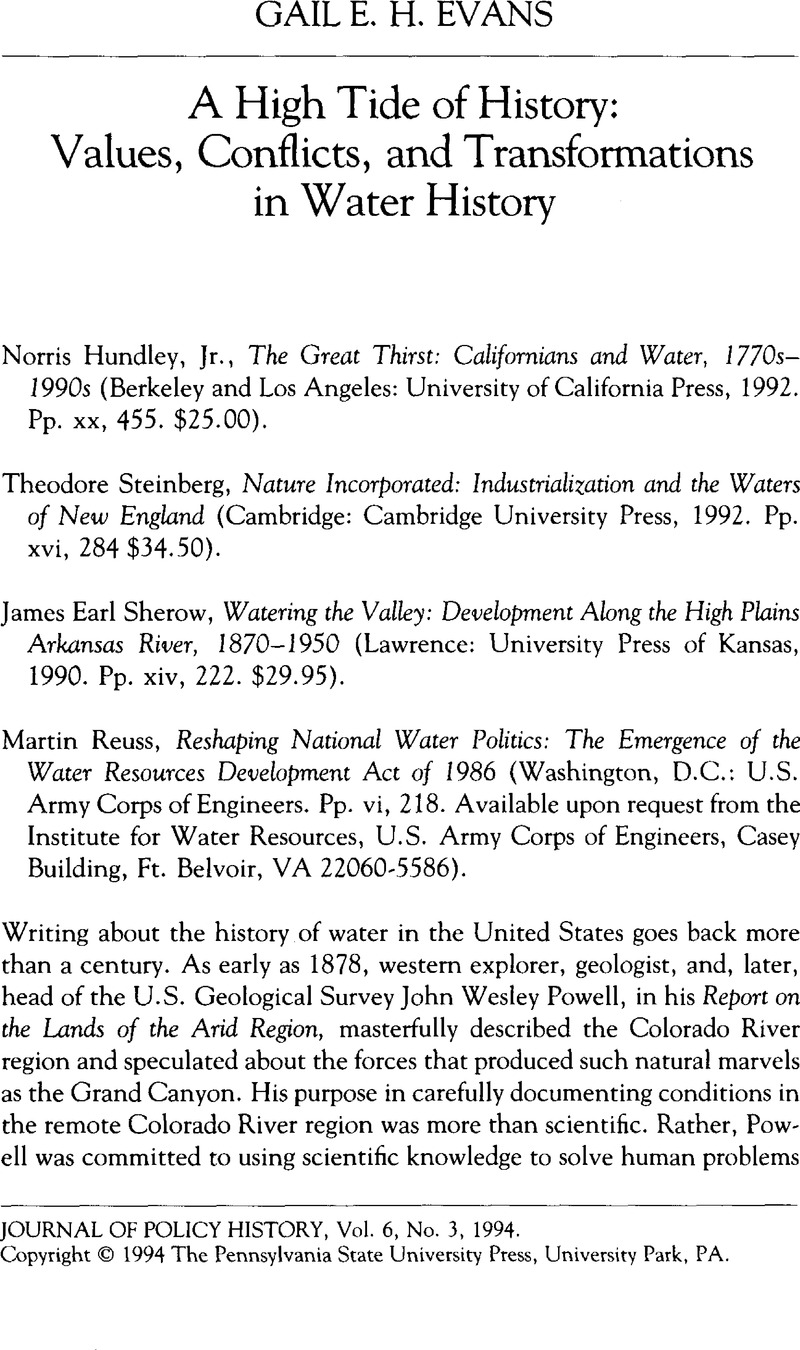No CrossRef data available.
Article contents
A High Tide of History: Values, Conflicts, and Transformations in Water History
Review products
Published online by Cambridge University Press: 14 October 2011
Abstract

- Type
- Review Essay
- Information
- Copyright
- Copyright © The Pennsylvania State University, University Park, PA. 1994
References
Notes
1. Powell, J. W., Report on the Lands of the Arid Region of the United States (Washington, D.C., 1879), 1–45Google Scholar.
2. Representative water histories written by nonprofessional historians include: Smythe, William Ellsworth, The Conquest of Arid America (New York: Harper & Bros., 1900)Google Scholar; Newell, Frederick H., Irrigation in the United States (New York: T.Y. Crowell & Co, 1902)Google Scholar; and Mead, Elwood, Irrigation Institutions (New York: Macmillan, 1903)Google Scholar.
3. A useful overview of water-resource historiography is given by Lee, Lawrence B. in “Historiographical Essay: Water Resource History: A New Field of Historiography?,” Pacific Historical Review 62:4 (November 1988): 457–67CrossRefGoogle Scholar, and also Smallwood, J. B. Jr. in “Historical Perspective on Water and the Western Environment: A Selective Bibliography of Recent Writings,” Journal of the West 22 (April 1983): 3–8Google Scholar.
4. Hundley, Norris Jr., Dividing the Waters: A Century of Controversy Between the United States and Mexico (Berkeley and Los Angeles, 1966)Google Scholar; Lilley, William III and Gould, Lewis, “The Western Irrigation Movement, 1878–1902: A Reappraisal,” in Gressley, Gene M., ed., The American West: A Reorientation (Laramie, Wyo., 1966), 57–74Google Scholar; Lee, Lawrence B., “William Ellsworth Smythe and the Irrigation Movement: A Reconsideration,”Pacific Historical Review 41 (August 1972): 289–311CrossRefGoogle Scholar; Swain, Donald M., “The Bureau of Reclamation and the New Deal, 1933–1944,” Pacific Northwest Quarterly 61 (July 1970): 137–46Google Scholar; Green, Donald E., Land of the Underground Rain: Irrigation on the Texas High Plains, 1910–1970 (Austin, Tex., 1973)Google Scholar.
5. The range of topics taken up by water historians in the 1960s, 1970s, and 1980s, many of which focused on themes of political conflict, is represented by: Blake, Nelson M., Water for the Cities: A History of Urban Water Supply Problems in the United States (Syracuse, N.Y., 1956)Google Scholar; Richardson, Elmo, Dams, Parks, and Politics: Resource Development and Preservation in the Truman-Eisenhower Era (Lexington, Ky., 1973)Google Scholar; Hoffman, Abraham, Vision and Villainy: Origins of the Owens Valley-Los Angeles Valley Water Controversy (College Station, Tex., 1981Google Scholar; Kahrl, William L., Water and Power: The Conflict over Los Angeles Water Supply in the Owens Valley (Berkeley and Los Angeles, 1982)Google Scholar; King, Judson, The Conservation Fight: From Theodore Roosevelt to the Tennessee Valley Authority (Washington, D.C., 1959)Google Scholar; Hubbard, Preston J., Origins of the TVA: The Muscle Shoals Controversy (Nashville, Tenn., 1961)Google Scholar; McCraw, Thomas K., TVA and the Power Fight, 1933–1939 (Philadelphia, 1971)Google Scholar; Matthews, Olen Paul, Water Resources, Geography and Law (Washington, D.C., 1984)Google Scholar; Lyall, Thomas Angus, Power from Water (London, 1961)Google Scholar.
6. See Hundley, Norris, “The Dark and Bloody Ground of Indian Water Rights: Confusion Elevated to Principle,” Western Historical Quarterly 9 (October 1978): 155–82CrossRefGoogle Scholar; Hundley, , “The Winter's Decision and Indian Water Rights: A Mystery Reexamined,” Western Historical Quarterly 13 (January 1982): 17–42CrossRefGoogle Scholar; Pisani, Donald J., “Federal Reclamation and Water Rights in Nevada,” Agricultural History 51 (July 1977): 540–58Google Scholar; Pisani, , “Irrigation Water Rights and the Betrayal of Indian Allotment,” Environmental Review 10 (Fall 1986): 157–76Google Scholar; Pisani, , “State vs. Nation: Federal Reclamation and Water Rights in the Progressive Era,” Pacific Historical Review 51 (August 1982): 265–82CrossRefGoogle Scholar; Dunbar, Robert G., Forging New Rights in Western Waters (Lincoln, Neb., 1983)Google Scholar; McCool, Daniel, Command of the Waters: Iron Triangles, Federal Water Development, and Indian Water (Berkeley and Los Angeles, 1987)Google Scholar; Littlefield, Douglas, “Water Rights During the California Gold Rush: Conflict over Economic Points of View,” Western Historical Quarterly 14 (October 1983): 415–34Google Scholar.
7. See, for example, Pisani, Donald J., From the Family Farm to Agribusiness: The Irrigation Crusade in California and the West, 1850–1931 (Berkeley and Los Angeles, 1984)Google Scholar; Smith, Karen L., The Magnificent Experiment: Building the Salt River Reclamation Project, 1890–1917 (Tucson, 1986)Google Scholar.
8. Blake, Nelson M., Land into Water, Water into Land: A History of Water Management in Florida (Tallahassee, 1980)Google Scholar.
9. Worster, Donald, Rivers of Empire: Water, Aridity, and the Growth of the American West (New York, 1985)Google Scholar; Reisner, Marc, Cadillac Desert: The American West and Its Disappearing Water (New York, 1986)Google Scholar; Palmer, Tim, Stanislaus: The Struggle for a River (Berkeley and Los Angeles, 1982)Google Scholar; Palmer, , Endangered Rivers and the Conservation Movement (Berkeley and Los Angeles, 1986)Google Scholar. For general historiographical surveys and assessments of water histories, see Lee, Lawrence B., Reclaiming the American West: An Historiography and Guide (Santa Barbara, Calif., 1980)Google Scholar; Lawrence B. Lee, “Water Resource History,” 463–67; and Pisani, Donald J., “The Irrigation District and the Federal Relationship: Neglected Aspects of Water History,” in The Twentieth-Century West: Historical Interpretations, Nash, Gerald D. and Etulain, Richard W., eds. (Albuquerque, 1989), 257–92Google Scholar. For a historiographical review of recent environmental histories, see White, Richard, “American Environmental History: The Development of a New Historical Field,” Pacific Historical Review 54 (August 1983): 326–29Google Scholar.
10. In addition to books already cited by Donald J. Pisani, Abraham Hoffman, William Kahrl, and Donald Worster, Hundley acknowledges his scholarly indebtedness to: Kelly, Robert, Gold vs. Grain: The Hydraulic Mining Controversy in California's Sacramento Valley: A Chapter in the Decline of Laissez-Faire (Glendale, Calif., 1959)Google Scholar and Battling the Inland Sea:American Political Culture, Public Policy, and the Sacramento Valley, 1850–1986 (Berkeley and Los Angeles, 1989)Google Scholar.
11. Achenbaum, W. Andrew, “Politics, Power, and Problems: Perspectives on Writing Policy History,”Journal of Policy History 1 (1986): 227–28Google Scholar.
12. White, “American Environmental History,” 334.


